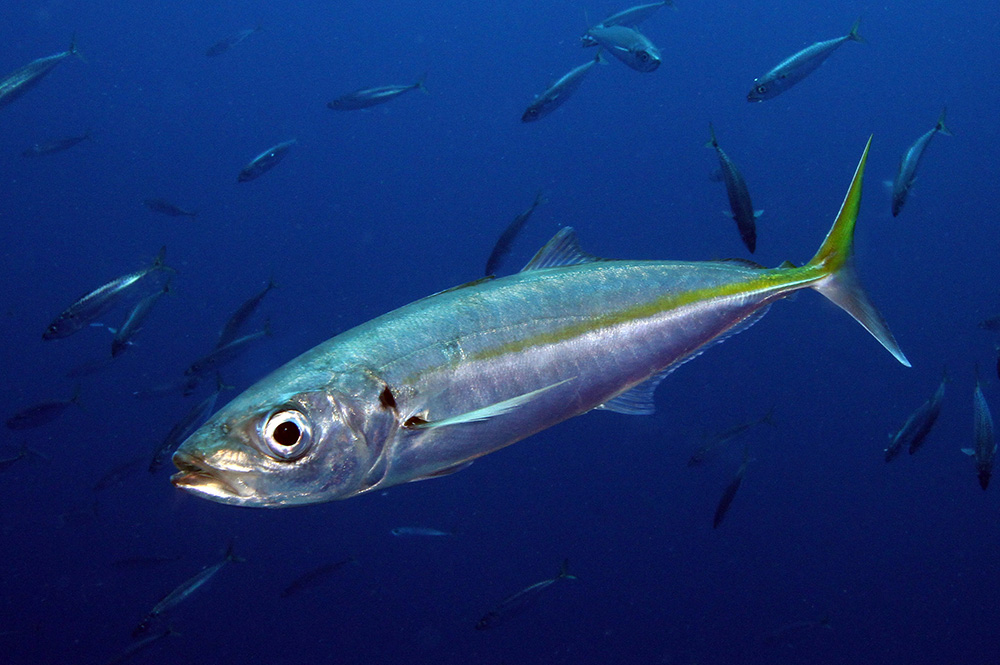Temperate Scad, Decapterus muroadsi (Temminck & Schlegel 1844)
Other Names: Amberstripe Scad, Mexican Scad, Southern Mackerel-scad

A Temperate Scad, Decapterus muroadsi, at Guadalupe, Mexico. Source: Paddy Ryan / http://www.ryanphotographic.com/carangidae.htm. License: All rights reserved
Cite this page as:
Bray, D.J. 2022, Decapterus muroadsi in Fishes of Australia, accessed 25 Apr 2024, https://fishesofaustralia.net.au/home/species/4271
Temperate Scad, Decapterus muroadsi (Temminck & Schlegel 1844)
More Info
|
Distribution |
Rockingham to north-west of Shark Bay (and perhaps further north), Western Australia, and Fish Rock to ENE of Bawley Point, New South Wales; also the Lord Howe Province in the Tasman Sea. Elsewhere the species is widespread in warm temperate waters of the Indo-West Pacific: New Zealand, Japan, the northwestern Hawaiian Islands, Rapa, Easter Island, Nazca Ridge and the eastern Pacific Ocean (Gulf of California to Peru). Although the Temperate Scad has been recorded from the mid-Atlantic Ocean (St Helena), this is thought to be a different species (Smith-Vaniz & Williams 2015). Forms pelagic schools in oceanic and inshore waters. |
|
Features |
Dorsal fin VIII+I, 28-32 (including detached rear finlet); Anal fin II+I,24-27 (including detached rear finlet); Gill rakers (including rudiments) 13-15 + 37-42. Body elongate, slender, cylindrical; eye covered with adipose eyelid except for central slit; rear margin of upper jaw straight above, not noticeably slanted anteroventrally, lower corner angular. Lateral line with long, low arch anteriorly; scales on top of head extend forward to level of anterior margin of pupil; branches of lateral line extending onto nape only. Pectoral fins short, tip of adpressed fins usually falling short of a vertical line from 2nd dorsal fin origin; tail base slender, caudal fin strongly forked |
|
Colour |
Bluish to olive green above, silvery yellow below; small black blotch on upper angle of operculum; membrane at front of top of roof of mouth white; yellowish stripe often present along sides extending onto upper lobe of caudal fin, fins otherwise pale. |
|
Feeding |
Feeds mostly on planktonic invertebrates. |
|
Etymology |
The specific name is from the Japanese muro-adsi, which is the its local name in Japan. |
|
Species Citation |
Caranx muroadsi Temminck & Schlegel 1844, Fauna Japonica 4(5–6): 108, pl. 58(1). Type locality: Japan. |
|
Author |
Bray, D.J. 2022 |
|
Resources |
Temperate Scad, Decapterus muroadsi (Temminck & Schlegel 1844)
References
Allen, G.R., Hoese, D.F., Paxton, J.R., Randall, J.E., Russell, B.C., Starck, W.A., Talbot, F.H. & Whitley, G.P. 1976. Annotated checklist of the fishes of Lord Howe Island. Records of the Australian Museum 30(15): 365-454 figs 1-2
Francis, M. 1993. Checklist of the coastal fishes of Lord Howe, Norfolk, and Kermadec Islands, southwest Pacific Ocean. Pacific Science 47(2): 136-170 figs 1-2
Francis, M.P. 2019. Checklist of the coastal fishes of Lord Howe, Norfolk and Kermadec Islands, southwest Pacific Ocean, Version: 2019.1, https://doi.org/10.6084/m9.figshare.c.4428305
Fricke, R., Kulbicki, M. & Wantiez, K. 2011. Checklist of the fishes of New Caledonia, and their distribution in the Southwest Pacific Ocean (Pisces). Stuttgarter Beiträge zur Naturkunde A, Neue Serie 4: 341-463.
Hutchins, J.B. 1994. A survey of the nearshore reef fish fauna of Western Australia's west and south coasts — The Leeuwin Province. Records of the Western Australian Museum, Supplement46: 1-66 figs 1-6
Hutchins, J.B. & Swainston, R. 1986. Sea Fishes of Southern Australia. Complete field guide for anglers and divers. Perth : Swainston Publishing 180 pp.
Johnson, J.W. 2010. Fishes of the Moreton Bay Marine Park and adjacent continental shelf waters, Queensland, Australia. pp. 299-353 in Davie, P.J.F. & Phillips, J.A. Proceedings of the Thirteenth International Marine Biological Workshop, The Marine Fauna and Flora of Moreton Bay. Memoirs of the Queensland Museum 54(3)
Kuiter, R.H. 1993. Coastal Fishes of South-eastern Australia. Bathurst : Crawford House Press 437 pp.
May, J.L. & Maxwell, J.G.H. 1986. Field Guide to Trawl Fish from Temperate Waters of Australia. Hobart : CSIRO Division of Marine Research 492 pp. (as Decapterus scombrinus)
Ogilby, J.D. 1898. New species of Australian fishes. Proceedings of the Linnean Society of New South Wales22(4): 759-761 (described as Decapterus leptosomus, type locality Port Jackson, NSW)
Okiyama, M. 1993. An atlas of the early stage fishes in Japan. Koeltz Scientific Books, Germany. 1154 pp.
Randall, J.E. 2005. Reef and shore fishes of the South Pacific. New Caledonia to Tahiti and the Pitcairn Islands. Honolulu : University of Hawaii Press 707 pp.
Smith-Vaniz, W.F. 1999. Family Carangidae. pp. 2659-2756 in Carpenter, K.E. & Niem, T.H. (eds). The Living Marine Resources of the Western Central Pacific. FAO Species Identification Guide for Fisheries Purposes. Rome : FAO Vol. 4 pp. 2069-2790.
Smith-Vaniz, W.F. & Williams, I. 2015. Decapterus muroadsi. The IUCN Red List of Threatened Species 2015: e.T20431538A45036107. http://dx.doi.org/10.2305/IUCN.UK.2015-4.RLTS.T20431538A45036107.en. Downloaded on 30 January 2018.
Temminck, C.J. & Schlegel, H. 1844. Pisces. pp. 73-112 pls 37-59, 60 (in part) in Siebold, P. Fr de (ed.) Fauna Japonica. Leyden : Apud Arnz & Socios Vol. 4(5–6) https://doi.org/10.5962/bhl.title.124951
Whitley, G.P. 1952. Figures of some Australian fish types. Proceedings of the Royal Zoological Society of New South Wales 1951-52: 23-31 figs 1-8 (as Decapterus leptosomus)





